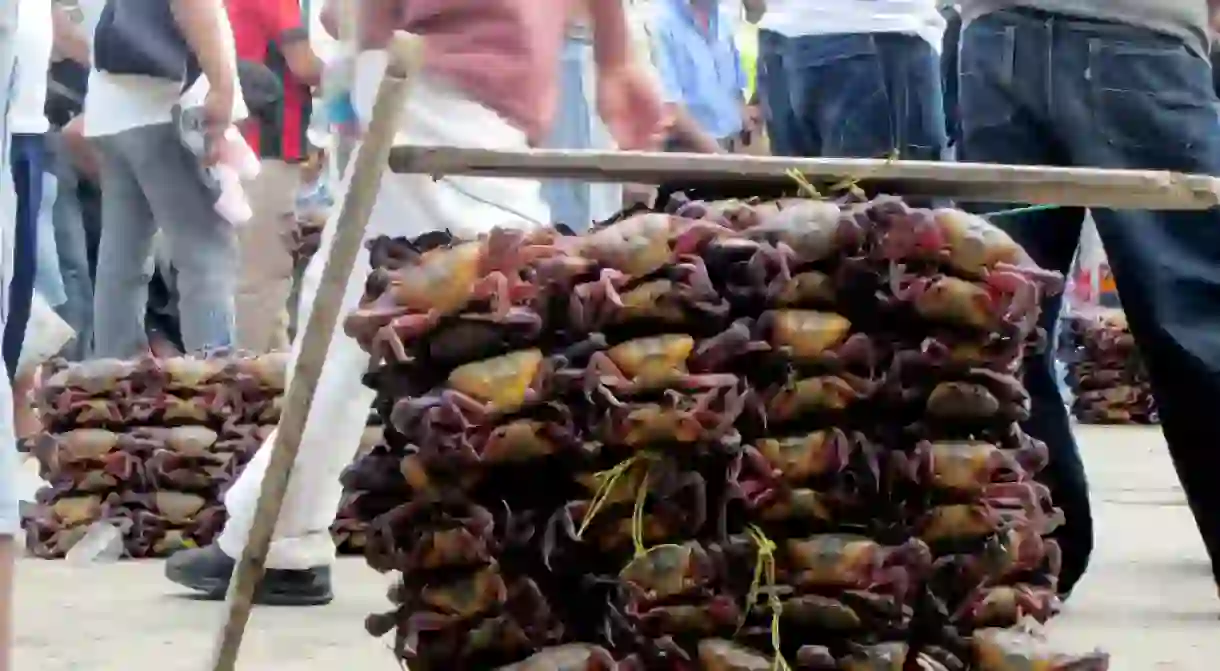The Best Markets to Visit in Guayaquil, Ecuador

In Guayaquil, the largest port city in Ecuador, markets abound. Locals use them to buy everything from fresh fruit and vegetables to delicious, fresh seafood. Few markets see tourists, though some are worth seeking out and a great way to better immerse yourself in coastal culture. Most markets are fast paced, especially when the pallets of crab arrive on the docks and Guayaquileños vie for the best ones. Here are our favorites.
Mercado Caraguay
Market

Located near the Isla Santay, this is the market most tourists choose to visit while touring Guayaquil. With more than 750 vendors, the Caraguay Market sells a little of everything but specializes in seafood, especially the famous crabs of Guayaquil. If you aren’t up to cooking your own seafood meal, then consider visiting one of the many small stands selling prepared food where locals can be found chowing down on ceviches, encebollados, and seafood dishes specializing crab.
Mercado Sauces 9
Market
With fewer than 400 vendors, the very local Sauces 9 Market is relatively small for the huge port city of Guayaquil. Yet locals flock to buy some of the best fresh seafood in town and to eat some of the better ceviches in the city. Adventurous foodies will find varieties of shellfish that have no English translations and ceviche mixtos with up to 8 different kinds of seafood.
Mercado La Florida
Market
The Florida Market is a great example of an everyday market in the big city, tucked well away from any center of tourism. Each product has a dedicated aisle. Fruit vendors pile their wares high, with bunches of plantains and bananas up top and bins of oranges and mandarinas costeñas in bins below. Vegetable vendors sell everything except potatoes… those can be found down a different aisle. At lunchtime, the market fills with lawyers and employees from the nearby court. The lunch spots with long lines are your best bet if you’re looking for excellent local food.
Mercado Central
Market
The Central Market was designed by Italian Architect Luigi Fratta and built in 1922-23. With about 300 vendors, it may not be the largest market in town but it definitely has the most variety. If you’re looking for grilled guinea pig rather than boiled crab, this is the place to go. Local food is on offer and the hornado con mote y salsa de maní(roast pork with hominy and peanut sauce) comes highly recommended.
Entre las calles 10 de Agosto, Clemente Ballén, 6 de Marzo y Lorenzo de Garaycoa
Mercado Central de Guayaquil mejor producto imposible! @Gastronomia_ECU @TurismoGuayas @sosbusiness_ec #proximidad pic.twitter.com/o6W6zJdrO4
— Alex Clavijo Aguiño (@AlexClavijoChef) 22 de abril de 2017
Entre las calles 10 de Agosto, Clemente Ballén, 6 de Marzo y Lorenzo de Garaycoa
Mercado Central de Guayaquil mejor producto imposible! @Gastronomia_ECU @TurismoGuayas @sosbusiness_ec #proximidad pic.twitter.com/o6W6zJdrO4
— Alex Clavijo Aguiño (@AlexClavijoChef) 22 de abril de 2017
Mercado Mapasingue Oeste
Market, Food Court
If you find yourself staying in the Samborondón neighborhood, check out the Mercado Mapasingue Oeste, a small but well-stocked market with a clean and inviting food court. They open at 6 am daily but get your shopping done early as the doors close at 3 pm.
Mercado Orgánico
Mercado Orgánico is not your typical Ecuadorian farmers market. Rather, it is a small store selling locally grown, organic produce. The concept of sustainable or even organic is still emerging, even in a big city like Guayaquil, so finding a store like this one can be tough. They are open Mondays through Saturdays. Owner Fernando Palacios is ready and waiting for your business and your special requests.
Mercado Orgánico, Urdesa, Guayaquil, Ecuador
Mercado Artesanal Guayaquil
Market
For those traveling to the Sierra of Ecuador, this small artisans’ market may not be worth a visit. But if the Ecuadorian Coast is your only stop, then this will be the best chance to stock up on Ecuadorian-style gifts to take back home. Vendors sell everything from Panama Hats (an Ecuadorian invention) to bars of specialty chocolate. Embroidered blouses, brightly patterned cotton pants, jewelry made from native seeds and vegetable ivory, and hand woven baskets are all favorite purchases.













